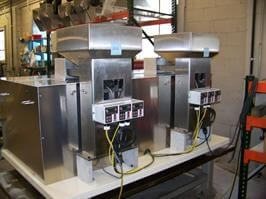 All vibratory feeder systems are complex. Variables of industry, part size, efficiency, and more require a delicate hand in designing systems that work for every unique organizational need. Understanding your company’s specific needs up front is necessary to ensure construction of a vibratory feeder that provides solutions.
All vibratory feeder systems are complex. Variables of industry, part size, efficiency, and more require a delicate hand in designing systems that work for every unique organizational need. Understanding your company’s specific needs up front is necessary to ensure construction of a vibratory feeder that provides solutions.
Here are 10 questions you need to have answered before you begin a vibratory feeder system project.
1. What is your feed rate? – The feed rate is the actual rate your assembly machine is running at. If you determine you need a system that handles 100 parts per minute, we need to design one that feeds 120 parts per minute to overcome any potential interruptions. Our goal is to include a buffer rate to exceed your rate requirements.
2. What is your part orientation? – The size and shape of your part will impact orientation, but does weight and the laws of physics. The orientation of your part is crucial to building an efficient vibratory system. Perhaps your part requires an added track to feed a part to meet system requirements. By understanding part orientation, we can improve efficiency, reduce steps, and increase the overall efficiency of a system.
3. Are you feeding multiple parts? – If you need a system to feed a range of parts, it’s much easier to design one early in the process. When parts change in the future, the requirements of the feeder system will shift, which can cause bottlenecks in production. Before designing a system, assessing all the sizes, shapes, and materials will translate to a better feed system.
4. Are your parts automation quality? – do you have multiple suppliers or production molds? What about flash issues – plastic pieces that sometimes hang off the part? Minor variations like these that relate to a parts automation quality, must be addressed when designing a vibratory feeder system.
5. Is there a design specification document or package of documents? – Design specification documents clearly define the expectations surrounding what the customer needs in a vibratory system. These documents cover topics like performance expectations, required features, preferred components, recommended color scheme, sound limitations, and much more.
6. How are parts being supplied to the feeder? – Vibratory feeder systems don’t operate properly if they’re too full or starving for parts. Your system should be designed to meter parts at a proper speed to reduce the number of operator touches and interactions. Your system should also be designed to ergonomic requirements and safety needs. You don’t, for example, want a hopper six feet off the ground when your operators are five feet tall.
7. What is your budget? – As with any project, how much you can spend will be a major factor. You have to assess whether to build a sophisticated assembly , or a lean cell with operator assist. You must also consider your up-front costs versus the total cost of ownership for your feeder system. Your budget will help dictate what you hope to accomplish.
8. What is your timeline? – The more we understand your overall build cycle of equipment, the better we can plan for design and assembly of your system. Another factor: how the role of your feeder system relates to a broader manufacturing or assembly plan.
9. Do you have any layout constraints? – Sometimes equipment must be sized to fit into a facility. We may have to manipulate equipment to fit into a specific space. We are able to provide two- or three-dimensional drawings of our proposed system, which helps with anticipating layout concerns.
10. Have you purchased a vibratory feeder system for a similar project before? -- We don’t want to reinvent the wheel, nor do we want to repeat past mistakes. By understanding previous experiences in designing and implementing feeder systems, it enables us to design new systems that capitalize on past experiences.
Asking these 10 questions before starting a vibratory feeder system project will position your project for heightened levels of success. To find out more about Hoosier Feeder Company and our processes, click here.
Related Topics: Bowl Feeders, Centrifugal Feeders, Feeder Systems, Linear Feeders, Modular Centrifugal Feeder, Parts Feeders, Puck Feeder System, Rotary Feeders, Vibratory Feeders, Feeder System Process Improvement